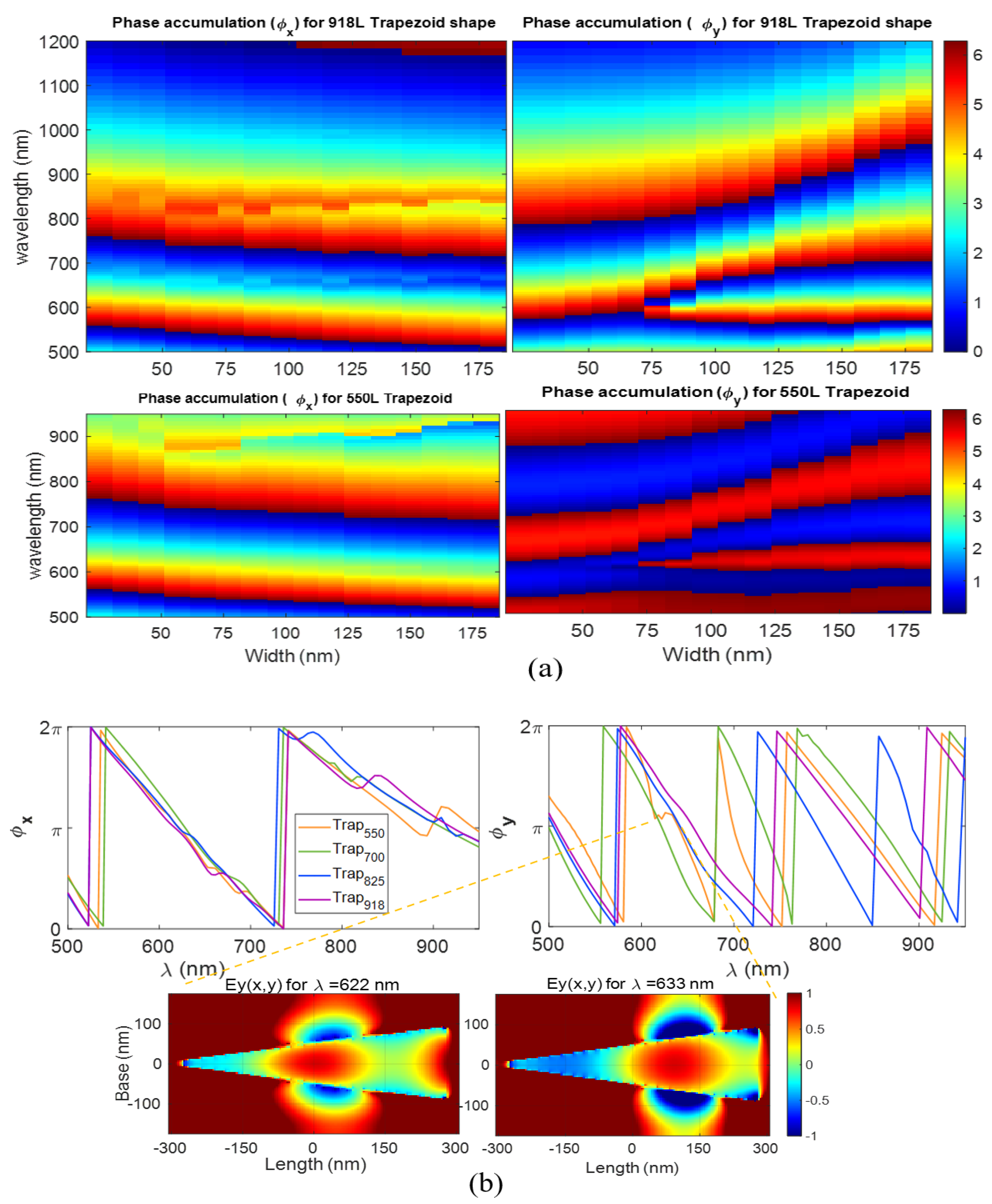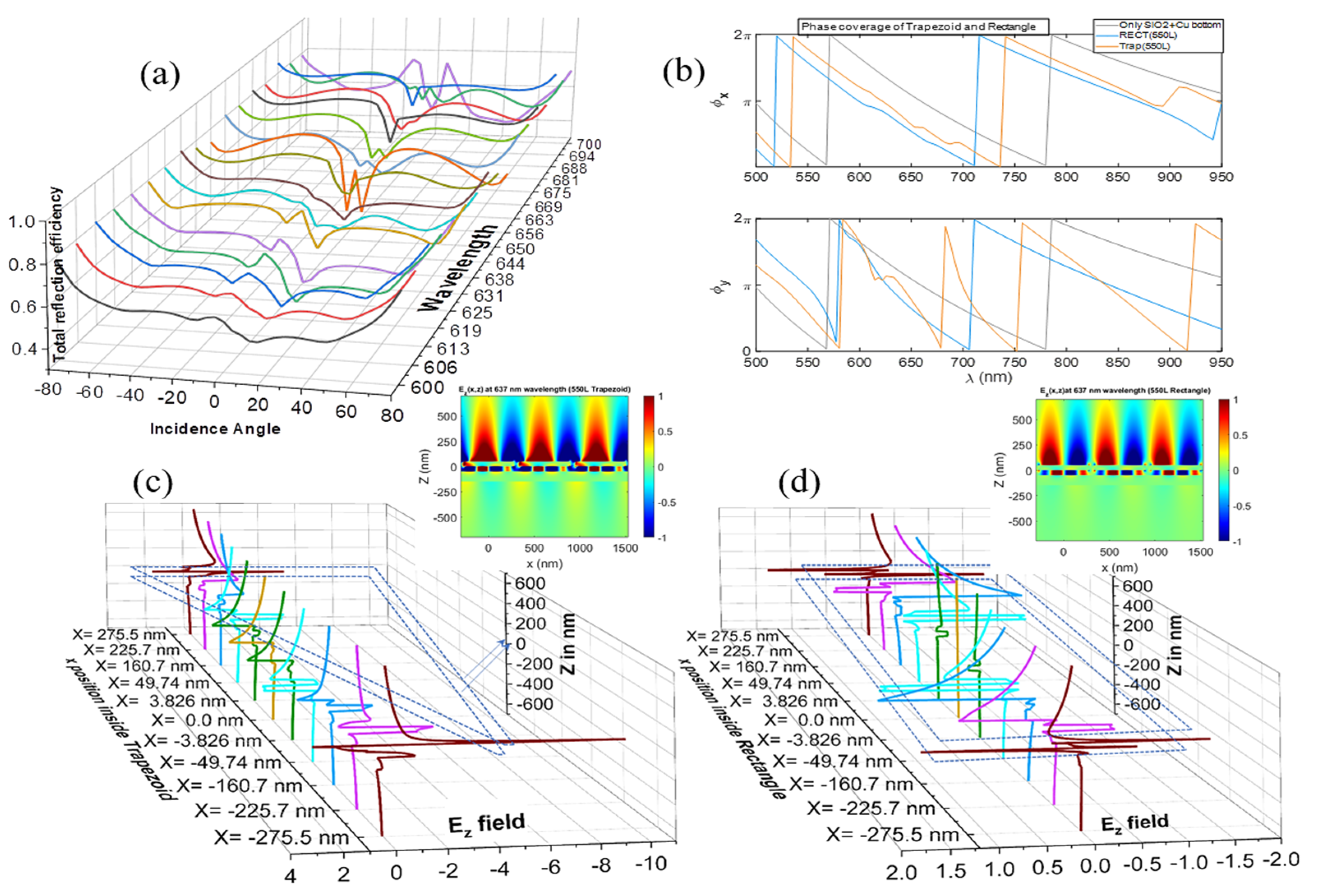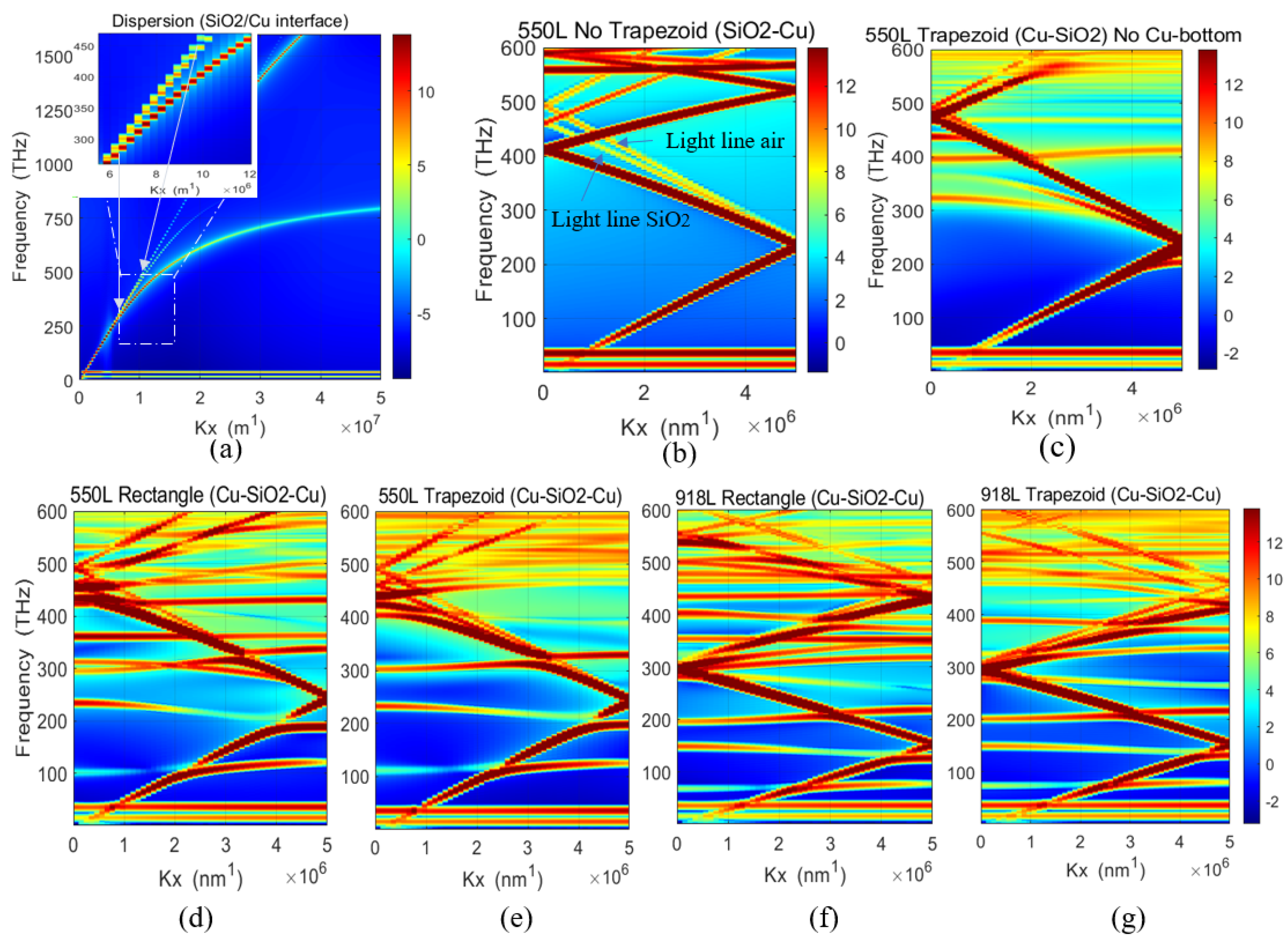Coupled Plasmon Wave Dynamics beyond Anomalous Reflection: A Phase Gradient Copper Metasurface for the Visible to Near-Infrared Spectrum
Abstract
:1. Introduction
2. Simulation and Modeling
3. Results and Discussion
4. Conclusions
Supplementary Materials
Funding
Institutional Review Board Statement
Informed Consent Statement
Data Availability Statement
Conflicts of Interest
References
- Luo, Y.; Kong, W.; Zhao, C.; Liu, K.; Pu, M.; Wang, C.; Luo, X. Subdiffraction nanofocusing of circularly polarized light with a plasmonic cavity lens. J. Mater. Chem. C 2019, 7, 5615–5623. [Google Scholar] [CrossRef]
- Ding, F.; Pors, A.; Bozhevolnyi, S. Gradient metasurfaces: A review of fundamentals and applications. Rep. Prog. Phys. 2017, 81, 026401. [Google Scholar] [CrossRef] [Green Version]
- Ni, X.; Kildishev, A.; Shalaev, V.M. Metasurface holograms for visible light. Nat. Commun. 2013, 4, 2807. [Google Scholar] [CrossRef]
- Chang, S.; Guo, X.; Ni, X. Optical Metasurfaces: Progress and Applications. Annu. Rev. Mater. Sci. 2018, 48, 279–302. [Google Scholar] [CrossRef] [Green Version]
- Li, Z.; Palacios, E.; Butun, S.; Aydin, K. Visible-Frequency Metasurfaces for Broadband Anomalous Reflection and High-Efficiency Spectrum Splitting. Nano Lett. 2015, 15, 1615–1621. [Google Scholar] [CrossRef] [PubMed] [Green Version]
- Zhang, C.; Divitt, S.; Fan, Q.; Zhu, W.; Agrawal, A.; Lu, Y.; Xu, T.; Lezec, H.J. Low-loss metasurface optics down to the deep ultraviolet region. Light. Sci. Appl. 2020, 9, 55. [Google Scholar] [CrossRef] [Green Version]
- Zhang, L.; Hao, J.; Qiu, M.; Zouhdi, S.; Yang, J.K.W.; Qiu, C.W. Anomalous Behavior of Nearly-Entire Visible Band. Nanoscale 2014, 6, 12303–12309. [Google Scholar] [CrossRef] [Green Version]
- Pors, A.; Bozhevolnyi, S. Plasmonic metasurfaces for efficient phase control in reflection. Opt. Express 2013, 21, 27438–27451. [Google Scholar] [CrossRef]
- Lee, J. Nonlinear and Wavelength-Tunable Plasmonic Metasurfaces and Devices. Ph.D. Thesis, The University of Texas at Austin, Austin, TX, USA, 2014. Available online: https://lib.utexas.edu/handle/2152/28053 (accessed on 21 October 2020).
- Zhang, Y.; Zhou, L.; Li, J.-Q.; Wang, Q.-J.; Huang, C.-P. Ultra-broadband and strongly enhanced diffraction with metasurfaces. Sci. Rep. 2015, 5, srep10119. [Google Scholar] [CrossRef] [Green Version]
- Gao, S.; Yue, W.; Park, C.-S.; Lee, S.-S.; Kim, E.-S.; Choi, D.-Y. Aluminum Plasmonic Metasurface Enabling a Wavelength-Insensitive Phase Gradient for Linearly Polarized Visible Light. ACS Photonics 2017, 4, 322–328. [Google Scholar] [CrossRef]
- Sun, S.; Yang, K.Y.; Wang, C.M.; Juan, T.K.; Chen, W.T.; Liao, C.Y.; He, Q.; Xiao, S.; Kung, W.T.; Guo, G.Y.; et al. High-Efficiency Broadband Anomalous Re flection by Gradient MetaSurfaces. Nano Lett. 2012, 12, 6223–6229. [Google Scholar] [CrossRef] [PubMed]
- Sun, S.; He, Q.; Xiao, S.; Xu, Q.; Li, X.; Zhou, L. Gradient-index meta-surfaces as a bridge linking propagating waves and surface waves. Nat. Mater. 2012, 11, 426–431. [Google Scholar] [CrossRef] [PubMed]
- Li, Z.; Kim, M.-H.; Wang, C.; Han, Z.; Shrestha, S.; Overvig, A.C.; Lu, M.; Stein, A.; Agarwal, A.M.; Lončar, M.; et al. Controlling propagation and coupling of waveguide modes using phase-gradient metasurfaces. Nat. Nanotechnol. 2017, 12, 675–683. [Google Scholar] [CrossRef]
- Aydin, K.; Ferry, V.; Briggs, R.M.; Atwater, H.A. Broadband polarization-independent resonant light absorption using ultrathin plasmonic super absorbers. Nat. Commun. 2011, 2, 517. [Google Scholar] [CrossRef] [PubMed]
- Brown, A.M.; Sundararaman, R.; Narang, P.; Goddard, W.A., III; Atwater, H.A. Nonradiative plasmon decay and hot carrier dynamics: Effects of phonons, surfaces, and geometry. ACS Nano 2016, 10, 957–966. [Google Scholar] [CrossRef]
- Lee, C.; Park, Y.; Park, J.Y. Hot electrons generated by intraband and interband transition detected using a plasmonic Cu/TiO2 nanodiode. RSC Adv. 2019, 9, 18371–18376. [Google Scholar] [CrossRef] [Green Version]
- Grillo, F.; Tee, D.W.; Francis, S.M.; Früchtl, H.A.; Richardson, N.V. Passivation of Copper: Benzotriazole Films on Cu(111). J. Phys. Chem. C 2014, 118, 8667–8675. [Google Scholar] [CrossRef]
- Palik, E.D. (Ed.) Handbook of Optical Constants of Solids; Academic Press: Orlando, FL, USA, 1985. [Google Scholar]
- Alrasheed, S.; Di Fabrizio, E. Design and simulation of reflect-array metasurfaces in the visible regime. Appl. Opt. 2017, 56, 3213. [Google Scholar] [CrossRef]
- Shi, H.; Li, J.; Zhang, A.; Jiang, Y.; Wang, J.; Xu, Z.; Xia, S. Gradient Metasurface with Both Polarization-Controlled Directional Surface Wave Coupling and Anomalous Reflection. IEEE Antennas Wirel. Propag. Lett. 2014, 14, 104–107. [Google Scholar] [CrossRef]
- Wang, Z.; Li, S.; Zhang, X.; Feng, X.; Wang, Q.; Han, J.; He, Q.; Zhang, W.; Sun, S.; Zhou, L. Excite Spoof Surface Plasmons with Tailored Wavefronts Using High-Efficiency Terahertz Metasurfaces. Adv. Sci. 2020, 7, 2000982. [Google Scholar] [CrossRef]
- Jiang, Q.; Xiang, H.; Han, D. Polarization-controlled generation and superposition of surface plasmon polariton vortices with a plasmonic metasurface. Appl. Phys. Lett. 2021, 119, 211102. [Google Scholar] [CrossRef]
- Gadalla, M.N.; Chaudhary, K.; Zgrabik, C.M.; Capasso, F.; Hu, E.L. Imaging of surface plasmon polaritons in low-loss highly metallic titanium nitride thin films in visible and infrared regimes. Opt. Express 2020, 28, 14536–14546. [Google Scholar] [CrossRef] [PubMed]
- Dai, Y. Imaging Light with Photoelectrons on the Nano-Femto Scale. Ph.D. Thesis, University of Pittsburgh, Pittsburgh, PA, USA, 2020. [Google Scholar]
- Estakhri, N.M.; Alù, A. Wave-front Transformation with Gradient Metasurfaces. Phys. Rev. X 2016, 6, 041008. [Google Scholar] [CrossRef] [Green Version]
- Han, Z.; Forsberg, E.; He, S. Surface plasmon Bragg gratings formed in metal-insulator-metal waveguides. IEEE Photonics Technol. Lett. 2007, 19, 91–93. [Google Scholar] [CrossRef]
- Zhang, J.; Zhang, L.; Xu, W. Surface plasmon polaritons: Physics and applications. J. Phys. D Appl. Phys. 2012, 45, 113001. [Google Scholar] [CrossRef]
- Berini, P. Long-range surface plasmon polaritons. Adv. Opt. Photonics 2009, 1, 484–588. [Google Scholar] [CrossRef]
- Li, J.; Li, J.; Zhou, H.; Zhang, G.; Liu, H.; Wang, S.; Yi, F. Plasmonic metamaterial absorbers with strong coupling effects for small pixel infrared detectors. Opt. Express 2021, 29, 22907–22921. [Google Scholar] [CrossRef]
- Prade, B.; Vinet, J.Y.; Mysyrowicz, A. Guided optical waves in planar heterostructures with negative dielectric constant. Phys. Rev. B 1991, 44, 13556. [Google Scholar] [CrossRef]
- Lu, D.; Das, A.; Park, W. Direct modeling of near field thermal radiation in a metamaterial. Opt. Express 2017, 25, 12999. [Google Scholar] [CrossRef]
- Pendry, J.B.; Martin-Moreno, L.; Garcia-Vidal, F.J. Mimicking surface plasmons with structured surfaces. Science 2004, 305, 847–848. [Google Scholar] [CrossRef]
- Zayats, A.V.; Smolyaninov, I. Near-field photonics: Surface plasmon polaritons and localized surface plasmons. J. Opt. A Pure Appl. Opt. 2003, 5, S16–S50. [Google Scholar] [CrossRef]
- Sharac, N.; Giles, A.; Perkins, K.; Tischler, J.; Bezares, F.; Prokes, S.M.; Folland, T.G.; Glembocki, O.J.; Caldwell, J.D. Implementation of plasmonic band structure to understand polariton hybridization within metamaterials. Opt. Express 2018, 26, 29363–29374. [Google Scholar] [CrossRef]
- Achanta, V.G. Surface waves at metal-dielectric interfaces: Material science perspective. Rev. Phys. 2020, 5, 100041. [Google Scholar] [CrossRef]
- Guo, B. Surface wave manipulation by plasmonic metasurface based on mode resonance. Sci. Rep. 2021, 11, 3313. [Google Scholar] [CrossRef] [PubMed]
- Dobmann, S.; Kriesch, A.; Ploss, D.; Peschel, U. Near-Field Analysis of Bright and Dark Modes on Plasmonic Metasurfaces Showing Extraordinary Suppressed Transmission. Adv. Opt. Mater. 2014, 2, 990–999. [Google Scholar] [CrossRef] [Green Version]
- Qiao, P.; Yang, W.; Chang-Hasnain, C.J. Recent advances in high-contrast metastructures, metasurfaces, and photonic crystals. Adv. Opt. Photon. 2018, 10, 180–245. [Google Scholar] [CrossRef] [Green Version]
- Chen, Z.; Hooper, I.R.; Sambles, J.R. Coupled surface plasmons on thin silver gratings. J. Opt. A Pure Appl. Opt. 2008, 10, 15007. [Google Scholar] [CrossRef]
- Lafferty, N. Evanescent Wave Assist Features for Optical Projection Lithography. Ph.D. Thesis, Rochester Institute of Technology, Rochester, NY, USA, 2011. [Google Scholar]
- Jin, J.; Li, X.; Guo, Y.; Pu, M.; Gao, P.; Ma, X.; Luo, X. Polarization-controlled unidirectional excitation of surface plasmon polaritons utilizing catenary apertures. Nanoscale 2019, 11, 3952–3957. [Google Scholar] [CrossRef]
- Pors, A.; Nielsen, M.G.; Bernardin, T.; Weeber, J.-C.; Bozhevolnyi, S. Efficient unidirectional polarization-controlled excitation of surface plasmon polaritons. Light Sci. Appl. 2014, 3, e197. [Google Scholar] [CrossRef] [Green Version]
- Davoyan, A.; Shadrivov, I.V.; Bozhevolnyi, S.I.; Kivshar, Y.S. Backward and forward modes guided by metal-dielectric-metal plasmonic waveguides. J. Nanophoton. 2010, 4, 043509. [Google Scholar] [CrossRef] [Green Version]
- Hooper, I.R.; Sambles, J. Coupled surface plasmon polaritons on thin metal slabs corrugated on both surfaces. Phys. Rev. B 2004, 70, 045421. [Google Scholar] [CrossRef] [Green Version]
- Salakhutdinov, I.; Sychugov, V.A.; Tishchenko, A.V.; Usievich, B.; Parriaux, O.; Pudonin, F.A. Anomalous reflection of light from the surface of a corrugated thin metal film. Quantum Electron. 1997, 27, 795–799. [Google Scholar] [CrossRef]
- Avrutsky, I.; Soref, R.; Buchwald, W. Sub-wavelength plasmonic modes in a conductor-gap-dielectric system with a nanoscale gap. Opt. Express 2009, 18, 348–363. [Google Scholar] [CrossRef] [PubMed] [Green Version]






| Material | Length/Base/Tip/Height (nm) | PL/PW (nm) | Max AR Angle/Efficiency | Effect | Wavelength Range (nm) | Reference |
|---|---|---|---|---|---|---|
| Ag/SiO2/Ag | 300/120/40/260 | 300/300 | Not reported | Perfect light absorption (~71%) | 400–700 | [15] |
| Ag/SiO2/Ag | 800/150/30/180 | 1000/200 | 52° for first order/(80–10%) | Light scattering | 500–800 | [5] |
| Au/SiO2/Au | 1200/320/100/320 | 1800/360 | 33.7° for first order/(50–95%) | Light scattering | 625–1525 | [10] |
| Al/SiO2/Al | 500/150/50/200 | 720/200 | 76° for first order/average 40% | Light scattering and effects of GSP mode | 400–700 | [11] |
| Cu/SiO2/Cu | 550–918/185/20/200 | 612–980/349 | 64° for first order/average 60% | Light scattering and directional coupled SPP waves | 500–1200 | This work |
Publisher’s Note: MDPI stays neutral with regard to jurisdictional claims in published maps and institutional affiliations. |
© 2022 by the author. Licensee MDPI, Basel, Switzerland. This article is an open access article distributed under the terms and conditions of the Creative Commons Attribution (CC BY) license (https://creativecommons.org/licenses/by/4.0/).
Share and Cite
Sultana, H. Coupled Plasmon Wave Dynamics beyond Anomalous Reflection: A Phase Gradient Copper Metasurface for the Visible to Near-Infrared Spectrum. Optics 2022, 3, 243-253. https://doi.org/10.3390/opt3030024
Sultana H. Coupled Plasmon Wave Dynamics beyond Anomalous Reflection: A Phase Gradient Copper Metasurface for the Visible to Near-Infrared Spectrum. Optics. 2022; 3(3):243-253. https://doi.org/10.3390/opt3030024
Chicago/Turabian StyleSultana, Hosna. 2022. "Coupled Plasmon Wave Dynamics beyond Anomalous Reflection: A Phase Gradient Copper Metasurface for the Visible to Near-Infrared Spectrum" Optics 3, no. 3: 243-253. https://doi.org/10.3390/opt3030024
APA StyleSultana, H. (2022). Coupled Plasmon Wave Dynamics beyond Anomalous Reflection: A Phase Gradient Copper Metasurface for the Visible to Near-Infrared Spectrum. Optics, 3(3), 243-253. https://doi.org/10.3390/opt3030024






